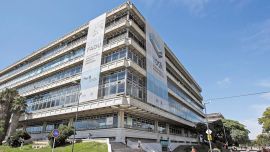The numbers are huge: eight million children live in poverty and 1.2 million in destitution or extreme poverty, according to a recent UNICEF report.
The percentage has been a few points up and down since the second half of 2018 when it was 47.2 percent, rising to 52.6 percent in 2019 and 58 percent in 2020, while dipping a bit to 51.2 percent child poverty in the first quarter of 2022 with 13.2 percent destitution.
Nevertheless, for the last five years, a half or more of Argentine children have been poor, according to UNICEF’s Monetary and Non-Monetary Poverty and Deprivation in Children and Adolescents in Argentina, which was constructed using data from the INDEC national statistics bureau and its Encuesta Permanente de Hogares household survey.
Protection and privations
UNICEF’s report attaches value to social protection policies, citing the Tarjeta Alimentar food card and the AUH (Asignación Universal por Hijo) child benefit payment as two examples. Without them, the figures would be “much worse,” says Sebastián Waisgrais, the UN body’s specialist monitoring social inclusion.
To carry out this investigation, the expert asked: “Who are the poorest among the poor?” As well as children, more cases of extreme poverty are to be found among women than among men.
María Claudia ‘La Negra’ Albornoz, of the La Poderosa civil association, says there has been a “feminisation of poverty” in recent years. “We women are impoverished. We generally head up households, working a triple day both inside and outside the house, as well as in the soup kitchens or school support,” she said in an interview.
More cases of extreme poverty are also noted in persons aged under 25 and those with less than six years of schooling - the fewer years in the classroom, the more extreme the poverty, according to the indicators.
Poverty also rises among those living in low-income neighbourhoods, in Central Argentina, Greater Buenos Aires and the Northeast. Monetary poverty is much greater among the unemployed and in single-parent households.
But not everything is explained by income. While monetary poverty refers to wages, earnings and the possible access to basic needs, there are also non-monetary privations related to a perhaps structural context such as access to education, public safety and the construction and location of the dwelling – whether or not close to a rubbish dump or a flood area, the quality of the bathroom and the access to drinking water, among other variables.
For example, a family that lives in decent housing whose children have access to a school but who cannot make it financially to the end of the month would not fit into this category. The non-monetary privations of children have decreased constantly between 2004 and 2022 although the number continues to be high. Some 69.6 percent were suffering non-monetary hardships in 2004 while last year the percentage was 42.5 percent with 15.4 percent of children undergoing severe privations.
One factor taken into account when evaluating non-monetary privations was “social protection” referring to the eligibility and access to social programmes. In the cases of severe hardships this is the most determining criterion, referring to children who are eligible for a programme but are still not receiving it. Thus “approximately one million children who are eligible for the AUH benefit are not receiving it,” explains Waisgrais.
Some of the reasons mentioned for this situation are penalising children who had not gone to school and who had started at the age of 13 and 14 years when many children younger in age are dropouts who have started to work.
There are 3.7 million children suffering both types of privations – they are poor in both monetary terms and in lack of rights. And two-thirds of Argentine children, a total of 8.8 million, suffer at least one of those two disadvantages.
Employment
One figure can throw light on the solution: formal employment. In households where the workers are not registered, child poverty rises to 60 percent whereas in homes with formal jobs it drops to 32 percent.
Quality employment is one of UNICEF’s recommendations for eradicating child poverty. Attention to childcare systems is also suggested so that women have access to quality jobs, apart from the specific and universal policies for tackling structural poverty in low-income neighbourhoods.
Nevertheless, “in 2022 the national budget allocated to children and adolescents was trimmed by 4.3 percent from the previous year in real terms,” along with 45 percent cuts in the budget dedicated to kindergartens and 18 percent in that dedicated to the prevention of teen pregnancy.
UNICEF representative Luisa Brumana explains: “We’re not monitoring any one government or the other but contributing towards government commitment. After 40 years of the return of democracy it is crucial that triggering political, social and economic agreements towards eradicating child poverty be the main priority on the public agenda.”
“We imagine people being born and falling on one side or the other of the poverty gap. Where do you fall? Do you choose where to fall?” asks Albornoz, a leading figure within one of Argentina’s 5,687 low-income neighbourhoods.
Over a million children and adolescents skip at least one meal daily, a recent qualitative study on the poverty situation in low-income neighbourhoods by La Poderosa revealed.
“We do not want soup kitchens, that they did not exist but they are absolutely necessary in the midst of so much crisis. I’ve suffered hunger and been to these canteens. That’s why I do this,” she explains.
“In these neighbourhoods the community networks are the first hand reaching out,” affirms the study. One social worker, who asked to remain anonymous, assures that there are over 260 people on the waiting-list of her soup kitchen: “You cannot tell them to wait, they’re hungry today!”
Albornoz interjects: “There are more people receiving a plate. You cannot say no to anybody.”
Crime and infrastructure
Life in Argentina’s poorest neighbourhoods also offers the likelihood of increased exposure to drugs and violence crime.
“Drug-trafficking and consumption are a suffocating part of the landscape, present in the streets, the corridors and sports pitches and bit by bit they are entering family and neighbourhood life,” points out UNICEF’s investigation.“Youngsters find in this [the drug business an amount of] money impossible to match with other kinds of work, whether with cooperatives or odd jobs.”
Albornoz explains the entry into drug-trafficking and consumption thus: “Kids who have lost every opportunity are very close at hand for somebody to come along and offer to sell. They begin by consuming and end up selling. That chain leads them to areas of crime placing their lives in danger where they end up in jail or dead.”
Contention is fundamental to avoid falling into the consumption of drugs. The UN report observes how “dropping out of school, confrontations and violence in its different forms pulls them away from their links with their loved ones.”
Albornoz adds: “We see them small and growing up and then we see how we lose them. That is the shock we want to transmit so that does not happen.”
The lack of drinking water is another urgent problem to solve. Multiple studies denounce that there are families living with lead in their blood, that most dwellings in low-income neighbourhoods have no sewage systems and that each family “makes their own septic tank within the home.” Some sewage mains drain directly into these neighbourhoods, making rainy days dangerous for various reasons with the outlets running over and flooding the neighbourhood with dirty water.
“We don’t have enough water to drink but more than enough stagnant water, forming lakes in some corners,” points out one neighbourhood representative.
Rainfall also creates another fatal danger: the risk of electrocution. There are precedents of this occurring in low-income neighbourhoods more than once – it is not just an unfounded fear. Vulnerable electricity connections can enter into contact with the water, causing a tragic outcome. Fire can also result from the same electricity connections or from burning rubbish to heat homes or cook.
“That’s part of daily reality. Sometimes they throw plastic into the fire and afterwards the kids have respiratory problems,” recounts one local woman who preferred not to give her name.
“Being poor shrinks your world. Where is the United States? Where is Spain? Where is France? Argentina played in Qatar, can that part of the world be imagined? The kids are abstracted from all that because they have not received the necessary education so that they cannot even begin to imagine. They cannot leave the place where they live, not even in their imaginations,” explains Albornoz.
“We are here to remove the stigma of being social plan recipients who like to live off the state and breed lots of children. That’s why we’re here. We lend our faces and voices to the numbers because if the personal is political, and so is life in the slums.”




















Comments